Bryanna Clark Grogan’s Vegan Feast Kitchen/ 21st Century Table: The kitchen journal of a vegan food writer.. I'm on Facebook and Twitter (see links in sidebar at right).
Thursday, April 23, 2009
FANTASTIC JAPANESE GOBO TASTING DINNER!

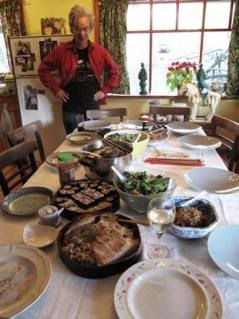
Our Host, Matsuki (pronounced "Matski") Masutani, surveying the feast.
Our friends (here on Denman Is.), Matsuki and Jane Masutani invited us to dinner last night. I had been discussing gobo (burdock root) with Matsuki a few days before, and told him I had heard of it, and maybe had eaten it, but didn't really know that much about it. He explained that this root vegetable is an integral part of Japanese cuisine and also has medicinal qualities. (In North America it is often regarded as an invasive weed! Here is a history of burdock root.)

Burdock plant
Here's a great description of an introduction to gobo from Tom at blisstree.com:
"Before I moved to Japan, I had never seen, tasted or even heard of burdock. Now I know why. It would have to be one of the strangest vegetables I have ever seen in a shop anywhere. To the untrained eye it looks like a dirty old stick, about a metre long and maybe as thick as your thumb at the thick end. It is covered with dirty brown “bark” and it really looks very unappetising. Talk about Cinderella!

Gobo (burdock roots)
When it makes it to you plate, it is hard to believe that you are eating the same thing that you would previously have used to play “fetch” with your dog. You see burdock isn’t a dirty old stick at all. It is actually a root or tuber and within it’s ugly duckling appearance is actually a beautiful vegetable.
The Japanese call Burdock Gobo and the Chinese use it as a medicinal herb, but Australians really don’t use it at all. So I was a loss as to how to cook this bizarre thing. Having, up until now, tried it cooked by others, I gave it a stab myself the other night. And I failed. There is a fine balance between cooking it enough to make it edible and plain old burning it. I lost the balance and the burnt burdock ended up in the compost. I haven’t given up yet and so will give it another go soon. It is definitely worth the trouble and so I will persist.
Burdock root is usually scraped, rather than peeled, and either shaved or julienned thinly. Its most popular recipe seems to be burdock kinpira, where it is sauteed with carrots, chilli, and the usual suspects of sake, mirin, soy and sugar."
Matsuki and Jane were hosting an old friend from Japan, Kazuko (pronounced Kah-zukoh, with the accent on the Kah), who is a wonderful musician, storyteller and actress-- and, apparently, a great cook, too! So, they invited us for a gobo tasting dinner last night. They provided the convivial atmosphere, music (a beautiful recording of the Dalai Lama "chanting", but it was actually more like singing and it was very enjoyable), salad, the brown rice, and the beverages. Kazuko; our mutual friends Yoshi and Susan-Marie Yoshihara (who made the greatest miso here on Denman Is.-- Shinmeido Miso); and Norie (pronounced Noree-ay) McGillivray, a young professional Japanese chef and cooking teacher (specializing in macrobiotics and sushi), all cooked traditional Japanese gobo dishes for us to sample (actually, we feasted!). They very kindly made everything vegetarian. (Also present was Norie's young son and the Masutani's lovely daughter-in-law, Nobue (pronounced Nohbu-ay.)
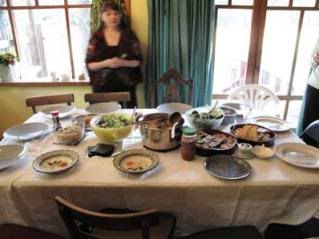
I wait for DH to finish taking pictures of the food before we can sit down and eat!
Susan-Marie grows gobo (burdock root) in her wonderful garden. She uses a Lee Valley Dandelion Digger to dig out the slim roots without breaking them-- good tip! If you are interested in growing burdock, it's hard to find info because of it's bad reputation as a weed in North America, but I found some good information here.
Anyway, on to the dinner. What a treat! What a delight to the senses! I don't have their recipes, but they did tell me some of the ingredients, and I am including online recipes to investigate.
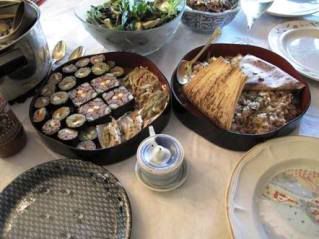
Norie brought the dishes above, some beautiful Soba-Sushi and Shikai-Sushi, along with some Kaki-Age (Julienned Vegetable Tempura) and Maze-Gohan (Japanese Rice Pilaf) wrapped in a banana leaf.
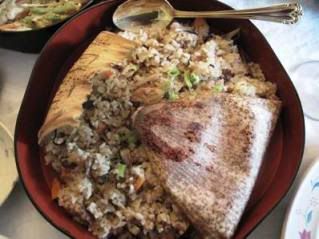
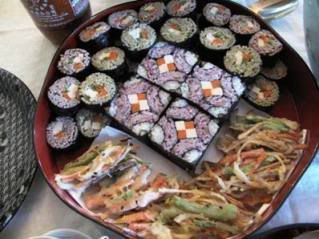
Norie is famous for her sushi here on Denman Is. (and rightly so!). Look at that beautiful Shikai-Sushi-- the square ones-- which translates to "Four oceans Sushi", Kazuko told me, because it looks like four waves closing in. The tempura (on the bottom) was delicious, too. Here are some online instructions for making Shikai-Sushi. And here's another page. (But neither tell you how to get the purple effect that Norie did-- I'll have to ask her about that! UPDATE: a commenter noted that purple shiso leaves are used to color rice pink or purple, but here is an article on coloring sushi rice with common vegetables.)
Here is a page on how to make Soba-Sushi (Norie made two kinds-- one with buckwheat soba [Japanese noodles] and one with spinach soba).
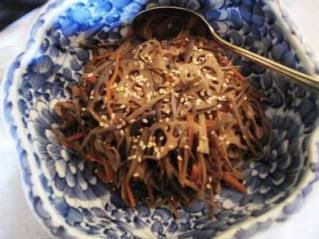
Norie also brought a type of salad, Classic Kinpira Gobo, made with burdock and carrot. It was delightful! Here is a recipe for it.
Yoshi also brought a dish of Maze-Gohan (Japanese Rice Pilaf), but it was a bit different from Norie's (I don't know what she put in hers). Yoshi's was Yuba-Maze-Gohan, containing strips of simmered yuba, hijiki seaweed,ginger pickle, soy sauce, sugar, and sesame oil. He instructed us to roll spoonful of it in squares of nori seaweed-- it was delicious that way! Here's a basic recipe for Maze-Gohan, but you can use all sorts of ingredients in it. I really liked the yuba in it! Yoshi said you could add a dash of hot sauce, such as Thai hot sauce, also known as Sriracha or "rooster sauce", if you like.
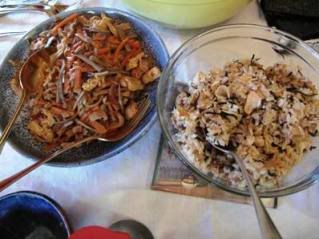
Yoshi's second dish was Kiriboshi-Daikon, a salad made with shredded carrot, strips of fried tofu (atsuage), onion, soy sauce, sugar, sesame oil, and dried daikon radish. The dried daikon has a more intense flavor than the fresh radish, giving a pleasant "bite" to the salad. There is a recipe for this here and another one here.
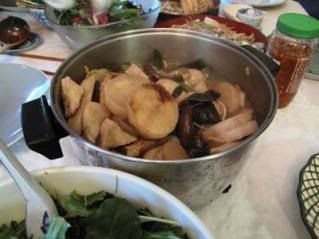
Kazuko made a delicious "Chinese-Style" Oden, or stew (I forgot to ask her why it was considered "Chinese-style"). It contained daikon radish, potato, burdock root, fried tofu (atsuage), seaweed, ginger, carrot, shiitake mushrooms, green onion, garlic, soy sauce, star anise, 5-spice powder (maybe that's the "Chinese-style" part?), sake, and sugar. There are many types of oden, but here is one recipe and here is another.
Kazuko also made a delicious appetizer, which we failed to photograph. She steamed carrots lightly (the Japanese prefer their root vegetables cooked) and cut them into pieces, and served them with a dip made of miso, crushed black sesame seeds, white wine, and sesame oil, if I remember rightly. It was absolutely scrumptious! She just made it up on the spot, so I have no idea of amounts, but I'm going to try to replicate it.
Susan-Marie provided the dessert, with two things from her garden-- it was a sort of crustless rhubarb custard "pie" (or pudding, I guess you could call it), made with only half of the usual sugar, due to the addition of the herb Sweet Cicily, which, according to Brenda Hyde, "It can be added to some dishes to reduce the sweetener, but it's not actually a sugar substitute."
It was really delicious! Unfortunately it got served and eaten before I could take a photo! Susan-Marie said she got the recipe from her friend and fellow Denman Is. Gardener, Phyllis Fabbi, but I found a similar recipe, for a Rhubarb and Sweet Cicely Pudding Recipe from Yorkshire (not vegan, of course). I have a vegan recipe for Sour Creme Rhubarb-Orange Pie which might be a good place to try Sweet Cicely.
Kampai!

Labels:
burdock,
burdock root,
gobo,
Japanese cuisine,
oden,
vegetarian sushi
Subscribe to:
Post Comments (Atom)
4 comments:
What a wonderful feast Bryanna! Yum!!
Incidentally I have a gobo sitting on my counter since yesterday :)
That feast looks delicious, especially the sushi!
My guess on the purple colour is that she added finely crushed dried shiso leaves to the soba (they are a common ingredient for making onigiri or to be sprinkled over rice). They would have added a slighly adstringent and sour taste to the noodles.
Bryanna,
I tried Gobo in veg chinese restaurant(stir fried) and it is not my favorite. Isn't it a bit slimy?
However, I love Japanese food so maybe they know how to cook it. All the dishes look so delicious. Japanese dishes are simple but delicious. I wonder how Brian like those dishes with nori cause I know he doesn't like nori. :-) I love eating stuff rolled in nori just like Yoshi instructed. I wish I was there!
Debbie
Lily-- I'll ask Norie about the shiso-- I have heard of it, but never worked with it. Thanks!
Hi, Julie and Debbie! Wish you both had been there! Debbie-- I didn't find the gobo slimy.
Post a Comment